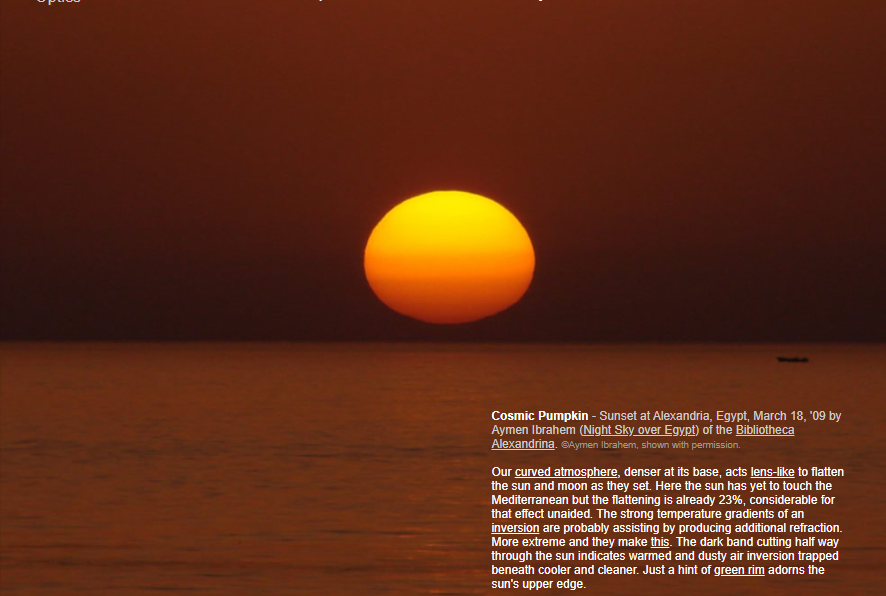Cosmic Pumpkin
The Cosmic Pumpkin: Unveiling the Enchanting Sunset Phenomenon
Have you ever gazed at a breathtaking sunset and wondered about the secrets behind its mesmerizing beauty? One captivating atmospheric optics phenomenon that adds a touch of magic to sunset views is known as the "Cosmic Pumpkin." In this article, we will delve into the fascinating details of this phenomenon and explore the science behind its occurrence.
Understanding the Cosmic Pumpkin
As the sun gracefully descends towards the horizon, our curved atmosphere comes into play, acting as a lens that alters the appearance of celestial bodies. The denser lower layers of the atmosphere cause a gradual flattening effect on the sun and moon as they set. This distortion is particularly pronounced when observed without any optical aids, such as binoculars or telescopes.
The Flattening Effect: A Visual Delight
The flattening effect produced by our atmosphere can be truly astonishing. Even before the sun touches the horizon, it can appear flattened by up to 23% when viewed from certain locations. This substantial alteration in shape adds a unique charm to the setting sun, captivating observers with its enchanting allure.
The Role of Temperature Gradients
In addition to the curvature of the atmosphere, temperature gradients also contribute to the Cosmic Pumpkin phenomenon. An inversion, characterized by strong temperature variations, can enhance the refraction of light, further distorting the appearance of the setting sun. When these temperature gradients become more extreme, they can intensify the flattening effect, creating even more remarkable visual displays.
Unveiling the Dark Band
A striking feature often observed during the Cosmic Pumpkin phenomenon is a dark band cutting through the sun. This band signifies the presence of an inversion where warm and dusty air is trapped beneath cooler and cleaner layers. This contrast in air properties creates a distinct boundary, adding depth and dimension to the flattened sun.
The Green Rim: A Subtle Elegance
If you look closely at the upper edge of the sun during the Cosmic Pumpkin phenomenon, you may notice a subtle hint of green. This green rim is a result of the sun's light being dispersed and refracted by the Earth's atmosphere. The scattering of shorter wavelengths, such as blue and green, is more pronounced, giving rise to this delicate and captivating green hue.
Exploring the Cosmic Pumpkin in Depth
While we have touched upon the main elements of the Cosmic Pumpkin phenomenon, there is still much to explore and understand. Researchers continue to study the intricate interplay between atmospheric conditions, temperature gradients, and refraction to gain deeper insights into this captivating spectacle.
A Delight for Skywatchers
The Cosmic Pumpkin phenomenon is a favorite among skywatchers and photographers alike. Its ethereal beauty has inspired countless artists to capture its essence in their works. From stunning photographs to breathtaking paintings, this phenomenon serves as a muse for those who seek to immortalize the wonders of the natural world.
Captivating Sunsets Around the World
Although the example provided in the original article showcases a sunset over Alexandria, Egypt, the Cosmic Pumpkin phenomenon can be witnessed in various locations worldwide. Different atmospheric conditions, geographical features, and local climates contribute to unique variations of this phenomenon, making each sunset a truly one-of-a-kind experience.
Embracing Nature's Splendor
In a world filled with hustle and bustle, taking a moment to appreciate the beauty of a Cosmic Pumpkin sunset can provide a sense of tranquility and awe. These enchanting displays remind us of the intricate wonders that exist in our natural surroundings and encourage us to pause, reflect, and connect with the world around us.
As we unravel the mysteries behind atmospheric optics phenomena like the Cosmic Pumpkin, we gain a deeper appreciation for the intricate workings of our planet. The next time you find yourself marveling at a stunning sunset, take a moment to ponder the magic of the Cosmic Pumpkin and let its enchantment fill your soul.

Cosmic Pumpkin - Sunset at Alexandria, Egypt, March 18, '09 by Aymen Ibrahem (Night Sky over Egypt) of the Bibliotheca Alexandrina. ©Aymen Ibrahem, shown with permission.
Our curved atmosphere, denser at its base, acts lens-like to flatten the sun and moon as they set. Here the sun has yet to touch the Mediterranean but the flattening is already 23%, considerable for that effect unaided. The strong temperature gradients of an inversion are probably assisting by producing additional refraction. More extreme and they make this. The dark band cutting half way through the sun indicates warmed and dusty air inversion trapped beneath cooler and cleaner. Just a hint of green rim adorns the sun's upper edge.
Note: this article has been automatically converted from the old site and may not appear as intended. You can find the original article here.
Reference Atmospheric Optics
If you use any of the definitions, information, or data presented on Atmospheric Optics, please copy the link or reference below to properly credit us as the reference source. Thank you!
-
<a href="https://atoptics.co.uk/blog/cosmic-pumpkin/">Cosmic Pumpkin</a>
-
"Cosmic Pumpkin". Atmospheric Optics. Accessed on April 20, 2024. https://atoptics.co.uk/blog/cosmic-pumpkin/.
-
"Cosmic Pumpkin". Atmospheric Optics, https://atoptics.co.uk/blog/cosmic-pumpkin/. Accessed 20 April, 2024
-
Cosmic Pumpkin. Atmospheric Optics. Retrieved from https://atoptics.co.uk/blog/cosmic-pumpkin/.